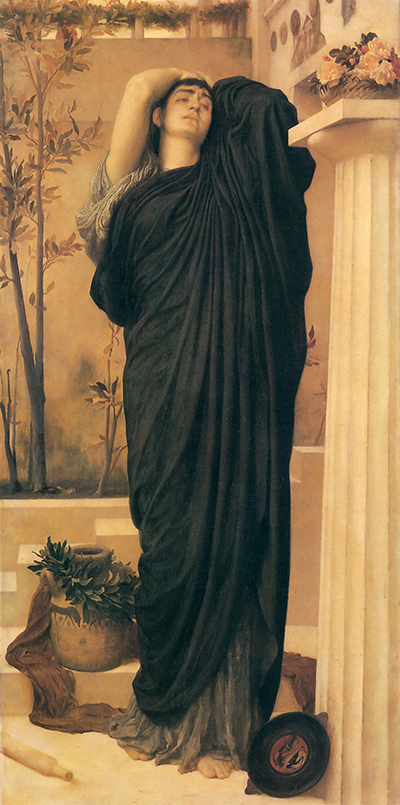Electra at the tomb of Agamemnon is a historical painting painted between 1868 and 1869. The painting draws from Greek mythology. In the myth, Electra mourns her father after he is murdered by his wife and her lover. While it was painted between 1868 and 1869 Fredric made sketches of the same around the 1860s. He sketched cream laid paper using black chalk.
In the final version which was about one and a half metres long, Fredric used oil on canvas. The painting features a tall lady, Electra, dresses in clothes of dull colours standing at Agamemnon's tomb. On her right are an open jar of water and a disc-like object on her left. A closer look at the centre of the disc-like object with the painting upside down reveals more. Two people, presumably male and female, face each other. The tomb is well decorated. There is a basket of fresh flowers next to her elbow. Colourful trees grow next to the tomb.
Loss, pain and distress are among the themes depicted in this painting. The expression on her face is sad and the manner in which she places her hand on her head shows that she is in intense anguish. She also appears to be in deep thought as her head is tilted upwards and she appears to be gazing at something absentmindedly as if she is reflecting on her plan for vengeance. Fredric choice of dull colours for Electra's clothes symbolises the dark phase and sorrow Electra is experiencing.
Lachrymae, meaning tears, is another of Frederic's paintings. It shares a lot in common with Electra at the tomb of Agamemnon. The Lady in Lachrymae is in pain just as Electra. Similarly, she is dressed in dull clothes and is leaning on a pillar. Again there is a disc-like object at her feet just like in Electra at the tomb of Agamemnon. William Blake Richmond also painted his own version of Electra at the tomb of Agamemnon in 1874. Several differences, however, stand between the two painting. Blake seems to dispute that Electra visited the tomb alone as depicted in Frederic's painting.
Was she not a princess after all? It is expected that she should have servants. There are four people in his painting, ladies an individual in a green clock, three ladies dressed in red. Of the three only one is standing. While Frederic chooses dull clothes for Electra, William chooses a flaming red colour for three of the four characters in his painting. This colour is very dominant and appears to highlight the need for vengeance and bloodshed in Electra unlike the dull colour in Frederic's painting that highlights sorrow.




